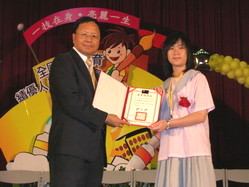Vocational Education helps build learning confidence among students
Date:

In order to offer junior high and vocational high school students diversified learning opportunities, the Ministry of Education has, implemented vocational and practical skills curricula.
Tu Cheng Sheng, the Minister of Education, says that the MOE in 1983, promoted the "Extended National Education Program Focused on Vocational Education." In 1993, junior high and vocational high students implemented the program.
The promotion phase of vocational skills ended in 2004 and mainstream education shifted its focus to career development. Moreover, starting in 2005, the vocational skills classes taught at vocational senior high schools were renamed "applied vocational skills" classes.
In 2003, a total of 1,043 vocational skills classes were given to 25,310 junior high school students. In 2006, 1,433 such classes were given to 33,448 junior high school students. Students were allowed to choose the field of their interest in order to more effectively implement vocational skills education.
In senior vocational high schools, a total of 379 classes were given in 2006 to 16,617 students. The vocational skills curriculum is employment-oriented. Besides offering students with lower academic aptitudes an alternative to higher education, it also helps them cultivate practical skills useful in the job market.
Minister Tu says that the vocational skills curriculum also enables students to discover the fun in learning and developing their technical talents. When vocational high school students graduate, the education they have received helps them compete in the domestic and overseas job markets or to seek higher education and improve their knowledge.
Attachment(s) for download
- Chinese textChinese text.doc
- Chinese textChinese text.doc
